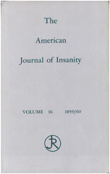Exclusion of close linkage of the dopamine transporter gene with schizophrenia spectrum disorders
Abstract
OBJECTIVE: Involvement of genetic factors in the pathogenesis of schizophrenia spectrum disorders has been indicated in twin, adoption, and familial aggregation studies; the pivotal role played by the dopamine transporter in dopaminergic neurotransmission makes it a candidate gene for these disorders. Detection of close linkage between a dopamine transporter marker and schizophrenia spectrum disorders would strongly support the existence of causal relationships between genetic mutations at the dopamine transporter locus and the disease phenotype. METHOD: The authors assessed the linkage between this gene and schizophrenia spectrum disorders by using polymorphic dopamine transporter gene markers in 156 subjects from 16 multiplex pedigrees with schizophrenia as well as schizophreniform, schizoaffective, and schizotypal disorders and mood-incongruent psychotic depression. RESULTS: Complete (theta = 0.0) linkage to the schizophrenia spectrum was excluded under both dominant and recessive models. CONCLUSIONS: These results indicate that allelic variants at the dopamine transporter locus do not provide major genetic contributions to the etiology of schizophrenia and related disorders in these pedigrees.
Access content
To read the fulltext, please use one of the options below to sign in or purchase access.- Personal login
- Institutional Login
- Sign in via OpenAthens
- Register for access
-
Please login/register if you wish to pair your device and check access availability.
Not a subscriber?
PsychiatryOnline subscription options offer access to the DSM-5 library, books, journals, CME, and patient resources. This all-in-one virtual library provides psychiatrists and mental health professionals with key resources for diagnosis, treatment, research, and professional development.
Need more help? PsychiatryOnline Customer Service may be reached by emailing [email protected] or by calling 800-368-5777 (in the U.S.) or 703-907-7322 (outside the U.S.).



